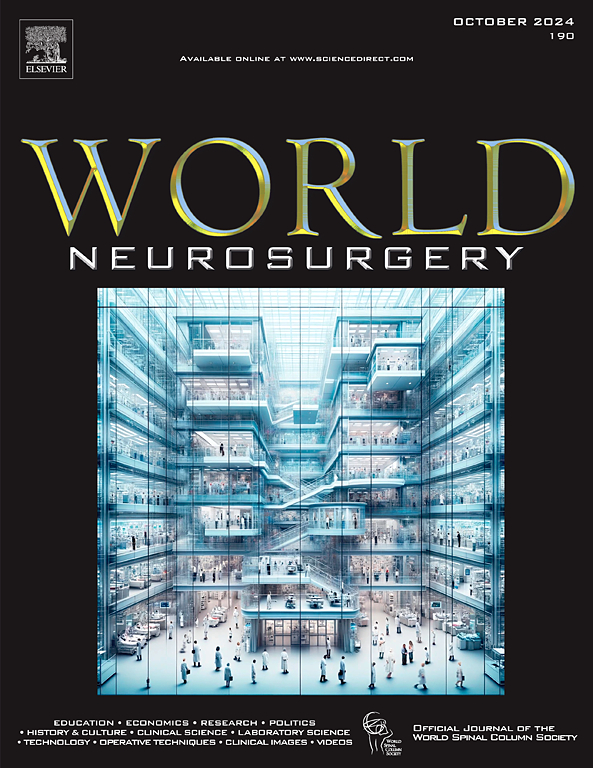Cervical Subcutaneous Fat Thickness and Its Association with Sagittal Parameters and Clinical Outcomes Following Laminoplasty in Patients with Cervical Spondylotic Myelopathy
IF 1.9
4区 医学
Q3 CLINICAL NEUROLOGY
引用次数: 0
Abstract
Objective
To investigate the association between cervical subcutaneous fat thickness, sagittal alignment parameters, and clinical outcomes following laminoplasty in patients with cervical spondylotic myelopathy (CSM).
Methods
A total of 131 patients with CSM who underwent single-door cervical laminoplasty between January 2021 and June 2023 were retrospectively analyzed, with an average follow-up period of 14.02 ±1.45 months. Subcutaneous fat thickness at the C5 vertebral level and skin-to-lamina distance were measured. Demographic characteristics, cervical sagittal parameters, surgical details, and postoperative outcomes were collected. Interobserver reliability was assessed using intraclass correlation coefficient. Binary logistic regression and receiver operating characteristic curve analyses were conducted to identify predictors of postoperative axial symptoms.
Results
Patients with greater subcutaneous fat thickness exhibited higher body mass index, greater body weight, shorter cervical length, smaller C2–C7 Cobb angles, higher T1 slope, and more severe paraspinal muscle fatty infiltration (all P < 0.05). The average of follow-up time is 14.02 ±1.445 months. There are no differences in final Japanese Orthopaedic Association and visual analog scale follow-up. But thicker subcutaneous fat patients have a higher incidence of postoperative axial symptoms (P = 0.02). Subcutaneous fat thickness was identified as the strongest independent predictor of axial symptoms (B = 0.828, P = 0.002), with receiver operating characteristic analysis showing moderate predictive ability (area under the curve = 0.64) and an optimal cutoff value of 1.357 cm.
Conclusions
Greater cervical subcutaneous fat thickness is associated with abnormal sagittal alignment and increased risk of postoperative axial symptosms after laminoplasty. Subcutaneous fat thickness may serve as a practical localized predictor to optimize surgical planning and postoperative management in CSM patients.
脊髓型颈椎病患者椎板成形术后颈部皮下脂肪厚度与矢状参数和临床结果的关系。
目的:探讨脊髓型颈椎病(CSM)患者椎板成形术后颈椎皮下脂肪厚度、矢状面排列参数与临床结果的关系。方法:回顾性分析2021年1月至2023年6月间行单门颈椎板成形术的131例CSM患者,平均随访时间14.02±1.45个月。测量C5椎体水平皮下脂肪厚度和皮肤到椎板距离(SLD)。收集人口统计学特征、颈椎矢状面参数、手术细节和术后结果。采用类内相关系数(ICC)评估观察者间信度。采用二元logistic回归和受试者工作特征(ROC)曲线分析来确定术后轴向症状的预测因素。结果:皮下脂肪厚度越大的患者BMI越高,体重越大,颈椎长度越短,C2-C7 Cobb角越小,T1斜率越高,棘旁肌脂肪浸润越严重(均为p)。结论:颈椎皮下脂肪厚度越大,椎板成形术后矢状面排列异常,轴向症状风险增加。皮下脂肪厚度可以作为一种实用的局部预测因子来优化CSM患者的手术计划和术后管理。
本文章由计算机程序翻译,如有差异,请以英文原文为准。
求助全文
约1分钟内获得全文
求助全文
来源期刊

World neurosurgery
CLINICAL NEUROLOGY-SURGERY
CiteScore
3.90
自引率
15.00%
发文量
1765
审稿时长
47 days
期刊介绍:
World Neurosurgery has an open access mirror journal World Neurosurgery: X, sharing the same aims and scope, editorial team, submission system and rigorous peer review.
The journal''s mission is to:
-To provide a first-class international forum and a 2-way conduit for dialogue that is relevant to neurosurgeons and providers who care for neurosurgery patients. The categories of the exchanged information include clinical and basic science, as well as global information that provide social, political, educational, economic, cultural or societal insights and knowledge that are of significance and relevance to worldwide neurosurgery patient care.
-To act as a primary intellectual catalyst for the stimulation of creativity, the creation of new knowledge, and the enhancement of quality neurosurgical care worldwide.
-To provide a forum for communication that enriches the lives of all neurosurgeons and their colleagues; and, in so doing, enriches the lives of their patients.
Topics to be addressed in World Neurosurgery include: EDUCATION, ECONOMICS, RESEARCH, POLITICS, HISTORY, CULTURE, CLINICAL SCIENCE, LABORATORY SCIENCE, TECHNOLOGY, OPERATIVE TECHNIQUES, CLINICAL IMAGES, VIDEOS
 求助内容:
求助内容: 应助结果提醒方式:
应助结果提醒方式:


